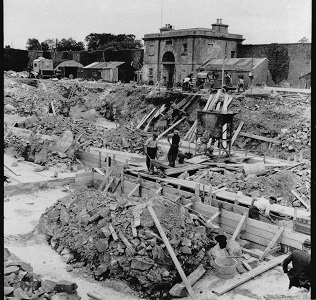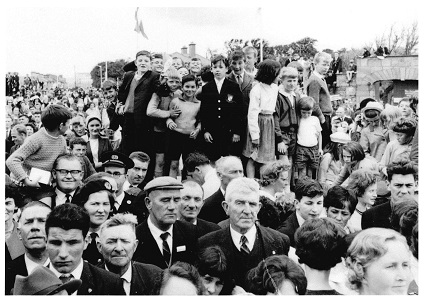GALWAY CATHEDRAL

by Tom Kenny
The first bishop of the Diocese was George Browne (1831-1844). He was followed by Lawrence O’Donnell (1844-1855); John McEvilly (1955-1883); Francis Carr (1883-1888); Francis McCormack (1888-1908); Thomas O’Dea (1908-1923); Thomas Doherty (1923-1936) and Michael Browne (1937-1976).
All of them used the Parish Church at the corner of Middle Street and Abbeygate Street as a pro-cathedral but all of them really wanted to build a new cathedral for the city. A fund was started as early as 1876. In 1909, Bishop McCormack bought the Shambles Barracks on Bridge Street with a view to building there. It was eventually decided that the site was too small and St. Patrick’s School was built there instead. The fundraising continued and when Michael Browne became bishop, he began to really push the idea of the cathedral. He even once drew up plans to have it constructed in Eyre Square, (even though did not belong to the church) but again, there would have been no parking facilities, so the idea was dropped.
The gaol was closed down by the Minister on May 1st, 1939, and handed over to the County Council. On March 15th, 1941, they in turn handed it over to the bishop who had earmarked the location as the site for his cathedral. John Robinson of Robinson, Keefe and Devane designed the building. In 1957, the plans were finalised and on February 1st, 1958, work began. John Sisk was the builder who undertook to build the actual fabric of the massive stone building from foundation to dome, excluding interior works such as heating, lighting and ecclesiastical fittings. From the start, various obstacles threatened to hold up work but under the guidance of the site manager Jack Lillis, Martin Cullen, clerk of works, and Joe Keane, site engineer, not to mention the workforce, these were all overcome. The actual building process was slow because of the vast amount of natural stone used in construction.
It did not make much of an impression on Galwegians first as all of the activity took place behind the high gaol walls, but as the cathedral façade began to grow and to be seen over those walls, it became a source of fascination. Never before had anything of this scale been constructed in Galway. It was successful on many levels and the workmanship was of a very high quality.
It was a particular joy to watch the stonemasons at work, walking slowly around a big lump of rock, studying it and then cleaving it open with one belt of a hammer and chisel, all under the watchful eye of stonemason foreman, Jim Freeman. No more than five masons and three apprentices worked on the building at any one time. Among them were Mick McGrath, Tom Barrett, Mick O’Neill, John Richardson, George Richardson, and apprentices George Richardson Junior, Jimmy Freeman and Mick O’Donnell. “We dressed and tempered our own tools including punches, chisels and pitchers. When dressing stone, not more than one eight of an inch of error was allowed”.

For tool making, each quarry had its own bellows and anvil. The stone came from quarries in Ballinasloe and Angliham, Coolough and Killians. A special mortar, with sand and gravel from Lee’s of Moycullen, combined with lime, ensured that the building fabric was not sullied by inferior pointing. Stone used on outside sills and jambs as well as the three rose windows came from Ballinasloe. All columns, sills and jambs on the inside of the building are of Coolough rock. The warden’s houses on Gaol Road were knocked and in 1967, the bishop handed over the vacant site to Galway Corporation.
Sadly, the men who actually built the cathedral were not allowed attend the opening.
The Stations of the Cross were carved in white Portland Stone by Gabriel Hayes Ó Ríordáin. Some of the other artists who contributed pieces include George Campbell, Patrick Pollen, Gillian Quirke, Patrick Heney, Manus Walsh, John Murphy, James Scanlan, George Walsh, Phyllis Burke and Róisín Dowd-Murphy.
The cathedral was formally opened on this day, August 15th, 1965, so we have two images for you today to celebrate that anniversary. The first shows the laying of the foundations. You can see the inside of the entrance gate to the gaol in the background. The second shows some of the local Galwegians who gathered outside the cathedral on the day of the opening.
.png)